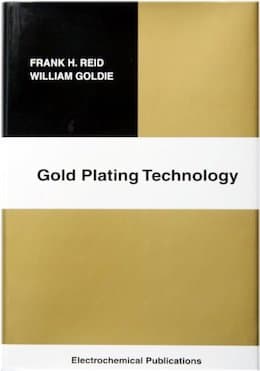
Curated with aloha by
Ted Mooney, P.E. RET

The authoritative public forum
for Metal Finishing 1989-2025

Thread 144/34
Adhesion between Ni and Au plating
Q. Dear All,
I have gone through your discussion and found it very helpful. However, even though I tried all these tricks, I could not get the adhesion of electroless gold deposited (non-cyanide sulphate bath) on electroplated Nickel (sulphamate bath) on Copper substrate.
I kept the pH of gold bath acidic/neutral, I have even varied the temperature of bath from 45 °C to 70 °C. I also tried dipping the Nickel plated substrate into 5% HCl (cold/warm). Even still, I could not get adhesion between Nickel and Gold. Please let me know if there is any other solution to this problem.
Thanking you in advance.
Shrikant
- PUNE INDIA
May 31, 2021
publicly reply to S G KULKARNI
A. Hi Shrikant. First three quick questions:
• May we assume that the sulphamate nickel layer you are speaking of is freshly applied? That is, immediately after nickel plating you are doing a quick rinse then going right into the electroless gold tank? Because if you are trying to deposit onto "old" nickel, that's an entirely different problem :-)
• When you say 'electroless gold' are you sure you mean an autocatalytic electroless gold process? You are not speaking of IG -- immersion gold? (We have a dozen threads on ENIG.)
• Do you have good reason to trust your electroless gold process and thus for having confidence that the issue is the passivity of the nickel rather than an electroless gold process which isn't satisfactory?
Luck & Regards,

Ted Mooney, P.E. RET
Striving to live Aloha
finishing.com - Pine Beach, New Jersey
May 2021
publicly reply to Ted Mooney
June 1, 2021
Q. Sir Thank you so much for your response. Following are the answers to your queries.
"May we assume that the sulphamate nickel layer you are speaking of is freshly applied? That is, immediately after nickel plating you are doing a quick rinse then going right into the electroless gold tank? Because if you are trying to deposit onto "old" nickel, that's an entirely different problem :-)"
Ans: Our Nickel layer is freshly prepared. Immediately after nickel deposition, we just give DI water rinse and immerse it in gold electroless bath.
"When you say 'electroless gold' are you sure you mean an autocatalytic electroless gold process? You are not speaking of IG -- immersion gold?
Ans: Our electroless gold bath contains Gold dissolved in HCl and Nitric acid, Potassium sulphate, ethylene-di-amine and boric acid. Kindly let me know whether it is an immersion gold or autocatalytic gold.
"Do you have good reason to trust your electroless gold process and thus for having confidence that the issue is the passivity of the nickel rather than an electroless gold process which isn't satisfactory?"
Ans: No. We just got this bath composition from one of the research paper and we have prepare the bath. Really speaking this is the only electroless gold bath by which we got gold deposited on the Nickel, out of many which we tried. Therefore we continue to work on this bath. But now we are facing tough challenges of adhesion between nickel and gold deposition. Can you please suggest us any other bath compositions for electroless gold?
Thanking you in anticipation.
Regards,
- Pune, INDIA
publicly reply to Shrikant Kulkarni
A. Hi Shrikant, thanks for your replies.
• Going quickly from nickel plating to gold, as you are doing, is important.
• Language is a fluid thing, but throughout the postings on this website, and in the USA in general, we reserve the term "electroless plating" for autocatalytic processes, and we call displacement processes "immersion plating" or "IG". For those interested, Topic 18471 "Immersion gold plating vs. electroless gold plating" goes into the details. Thus your composition sounds like an immersion gold, and in fact many if not most non-cyanide gold electroplating solutions will immersion plate when warm (although not necessarily with satisfactory adhesion).
• Is there a good reason you are using a research-level plating solution? There are many proprietary brands of immersion gold processes and several brands of electroless gold processes, and the sellers will generally help you figure out the problems you have with their product.
Luck & Regards,

Ted Mooney, P.E. RET
Striving to live Aloha
finishing.com - Pine Beach, New Jersey
June 2021
publicly reply to Ted Mooney
![]() Thank you very much for your response Sir. We will go for commercial gold bath. Thank you once again for guiding us.
Thank you very much for your response Sir. We will go for commercial gold bath. Thank you once again for guiding us.
Best regards,
- Pune, INDIA
June 4, 2021
publicly reply to S G KULKARNI
⇩ Related postings, oldest first ⇩
2002
Q. I have just been assigned responsibility for a plating process. We are plating gold on top of Nickel on top of copper. My problem is adhesion between the nickel and gold.
I pattern the copper with a photoresist. Then clean in heated HCl, about 1 min. Then rinse in DI, and transfer wet to nickel plating bath, sulfamate base. Di rinse after ni plate, and transfer wet (to minimize oxidation of ni) to au plating bath, an alkaline, non-cyanide base. I strip the photoresist with acetone ⇦ this on eBay or Amazon [affil links] Warning! highly Flammable! , Ethanol, methanol [affil links], IPA soaks and rinses. I then etch the copper from the field using FeCl, heated, with agitation. DI rinse, soak and rinse, then dry.
The problem is the gold comes off when tape is applied and pulled off. I do observe and undercut from the FeCl etch of between 0.5 to 1 mils. When I rub at that I can not lift the gold off.
I have been able to improve adhesion by heating item to 225 °C for 4 min. on a hot plate. However, we are not sure we want to do that.
Can anyone give me suggestions of how to plate au to Ni? I would prefer not to use a cyanide based STRIKE product. Can I do a strike type step within the au plating step in my present solution? Is this accomplished with lower current density or higher? How long would I have to do the "strike" process?
Thanks so much in advance,
Linda Suppan- Chantilly, Virginia
publicly reply to Linda Suppan
|
"Gold Plating Technology"
by Reid & Goldie -- hard to find & expensive; if you see a copy cheap, act fast! 
on eBay or AbeBooks or Amazon (affil links) A. A simple reason may be loss of activation between Nickel and Gold. Going in "live" will help with that. Also the quicker the parts are transferred to the Gold the better.  Jim Conner Anoplex Software Mabank, Texas USA  2002 publicly reply to Jim Conner A. With the photo resist you need to be using an acid gold following an acid gold strike. The sulfamate solution of nickel must be clean and free from metallic and organic contamination and at a pH around 3.8 to 4.2. High pH disfavors gold adhesion.  Robert H Probert Robert H Probert Technical Services Garner, North Carolina  2002 publicly reply to Robert H Probert |
A. If your Nickel layer is clean enough you can directly do a gold strike (acid bath) then plate gold over the gold strike (acid bath). Lot of proprietary baths are available for Strike as well as acid baths.
A strike bath will also prevent carry over to gold bath and prevent the contamination of the gold bath. Acid bath is much preferred than Cyanide bath for many applications. The maintenance of Acid bath is quite simple compared to cyanide bath.
If you feel the nickel layer is not clean enough you can go for a Cathodic cleaning in alkali followed by 5% HCl dip then Gold strike and plate gold. This will have a very good adhesion to the base layer.
Good luck...
Karthik [last name deleted for privacy by Editor]- Singapore
2002
publicly reply to Karthik
A. Hello,
On my side I'm just cleaning the copper/brass with soap and hot water before nickel plating, and after nickel plating I'm not activating because it is freshly nickel plate, then I do 2x Di rinse, and then gold plate it is not coming off, also if I tape and pulled.

Dipen Pattni
jeweler/goldsmith - Dar-Es-Salaam, Tanzania
2002
publicly reply to Dipen Pattni
A. Hi,
I agree with Mr. Probert. Most photoresists contain gelatin which is dissolved by alkalines and some of the by-products of this attack might be getting on the nickel surface thus affecting adhesion of gold and allowing the undercut. Try with acid or neutral gold solutions?
Good luck.
Guillermo MarrufoMonterrey, NL, Mexico
2002
publicly reply to Guillermo Marrufo
A. Hi,
If you have a high level of brightener or leveling agent in your nickel solution this can show a bad adhesion between gold and nickel.
Regards,

Anders Sundman
4th Generation Surface Engineering
Consultant - Arvika,
Sweden
2002
publicly reply to Anders Sundman
A. Dear Linda,
I agree with the majority of the Authors who wrote in to indicate that adherent gold films could be deposited preferably from an acid bath on a substrate pre- coated with nickel without the use of a cyanide based STRIKE product. An alkaline bath could also be used depending on the requirement of the Customer of the product to be electroplated. I have actually electroplated coherent films of Au on aluminum or stainless steel substrate pre-coated with nickel without the application of cyanide. The key point is to keep the substrate clean, devoid of oxidation before the electroplating process commence. One also must have a good knowledge of electrochemical behaviour of metallurgy of materials to manipulate the necessary applicable variable. factors required for sound electroplating plating finishes.
Former GE and NASA Aerospace Engineer, Group Leader.

Bassey J. Udofot
Musgegon, Michigan
August 26, 2009
publicly reply to Bassey J. Udofot
Q. Having trouble with gold plate adhesion over nickel plate (sulfamate bath). Tape test pulls 100's off the gold pads off as well as a light rinse / wipe with DI water. However, if I drop the curent density by 20% it passes with flying colors. Something with the brighteners? Can these be pulled out with a carbon filter and then start fresh?
How to monitor for brighteners / additives? Hull Cell only method?
Engineer - South Portland Maine USA
February 4, 2011
publicly reply to Rich Wood
ASTM B488 question
Q. Paragraph 6.5.2 of ASTM B488 (2006) recommends a gold strike be applied to the underplate prior to plating the gold top coating. I have a few questions about this gold strike:
1. What is the typical thickness of the Gold Strike?
2. Is the Gold strike an electrolytic or electroless process?
3. What is the purpose of the Gold strike?
Thanks!
Engineer - Hauppauge, New York, USA
February 19, 2018
publicly reply to Bob Diamond
A. Hi Bob. We appended your inquiry to a thread which talks about it.
1. Thickness is only enough for coverage, probably a just visible layer.
2. The strike is electrolytic.
3. Probably the most important purpose of the strike is improved adhesion, but topic 37430 explains some additional justifications for and benefits of the gold strike. Good luck.
Regards,

Ted Mooney, P.E. RET
Striving to live Aloha
finishing.com - Pine Beach, New Jersey
February 2018
publicly reply to Ted Mooney
Q, A, or Comment on THIS thread -or- Start a NEW Thread